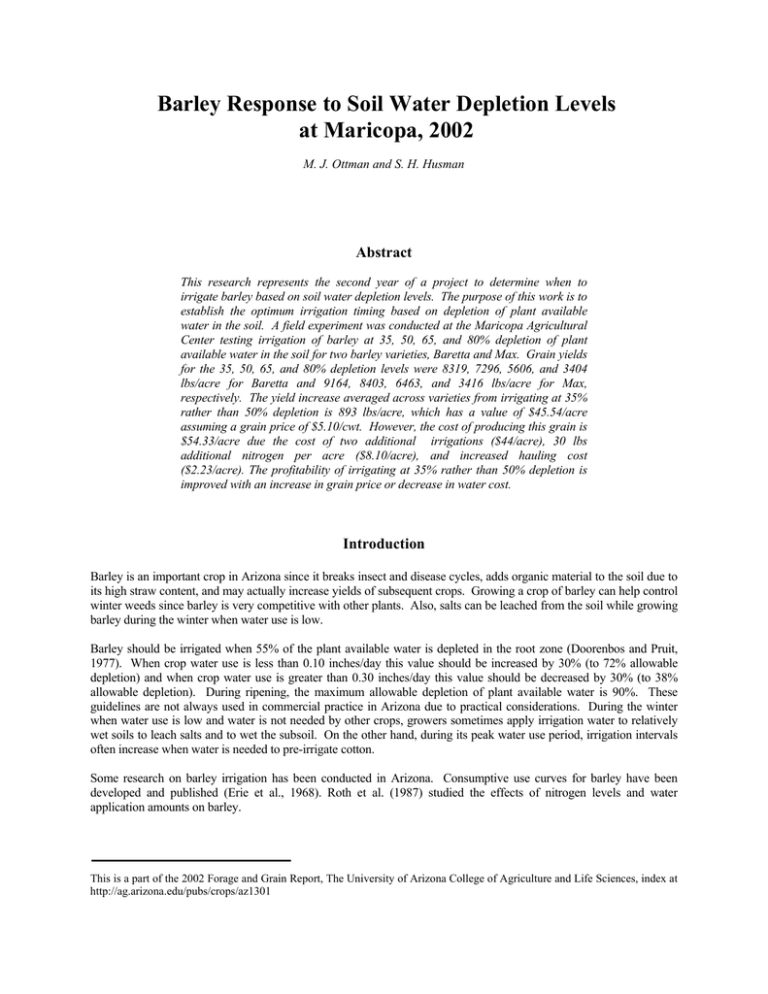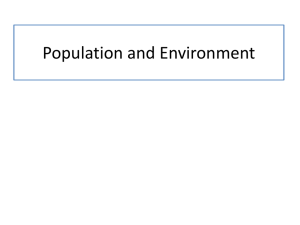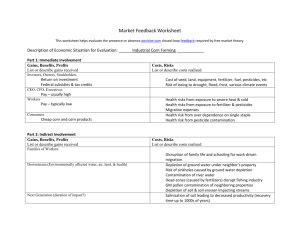Barley Response to Soil Water Depletion Levels at Maricopa, 2002 Abstract
advertisement

Barley Response to Soil Water Depletion Levels at Maricopa, 2002 M. J. Ottman and S. H. Husman Abstract This research represents the second year of a project to determine when to irrigate barley based on soil water depletion levels. The purpose of this work is to establish the optimum irrigation timing based on depletion of plant available water in the soil. A field experiment was conducted at the Maricopa Agricultural Center testing irrigation of barley at 35, 50, 65, and 80% depletion of plant available water in the soil for two barley varieties, Baretta and Max. Grain yields for the 35, 50, 65, and 80% depletion levels were 8319, 7296, 5606, and 3404 lbs/acre for Baretta and 9164, 8403, 6463, and 3416 lbs/acre for Max, respectively. The yield increase averaged across varieties from irrigating at 35% rather than 50% depletion is 893 lbs/acre, which has a value of $45.54/acre assuming a grain price of $5.10/cwt. However, the cost of producing this grain is $54.33/acre due the cost of two additional irrigations ($44/acre), 30 lbs additional nitrogen per acre ($8.10/acre), and increased hauling cost ($2.23/acre). The profitability of irrigating at 35% rather than 50% depletion is improved with an increase in grain price or decrease in water cost. Introduction Barley is an important crop in Arizona since it breaks insect and disease cycles, adds organic material to the soil due to its high straw content, and may actually increase yields of subsequent crops. Growing a crop of barley can help control winter weeds since barley is very competitive with other plants. Also, salts can be leached from the soil while growing barley during the winter when water use is low. Barley should be irrigated when 55% of the plant available water is depleted in the root zone (Doorenbos and Pruit, 1977). When crop water use is less than 0.10 inches/day this value should be increased by 30% (to 72% allowable depletion) and when crop water use is greater than 0.30 inches/day this value should be decreased by 30% (to 38% allowable depletion). During ripening, the maximum allowable depletion of plant available water is 90%. These guidelines are not always used in commercial practice in Arizona due to practical considerations. During the winter when water use is low and water is not needed by other crops, growers sometimes apply irrigation water to relatively wet soils to leach salts and to wet the subsoil. On the other hand, during its peak water use period, irrigation intervals often increase when water is needed to pre-irrigate cotton. Some research on barley irrigation has been conducted in Arizona. Consumptive use curves for barley have been developed and published (Erie et al., 1968). Roth et al. (1987) studied the effects of nitrogen levels and water application amounts on barley. This is a part of the 2002 Forage and Grain Report, The University of Arizona College of Agriculture and Life Sciences, index at http://ag.arizona.edu/pubs/crops/az1301 Apparently, research has not been conducted in Arizona to determine when to irrigate barley based on the allowable soil water depletion levels. Therefore, the purpose of this work is to establish the optimum irrigation timing based on depletion of plant available water in the soil. The research reported herein represents the second year of a two-year project. The results from the first year were reported previously (Husman et al., 2000). Materials and Methods A barley irrigation study was conducted at the University of Arizona Maricopa Agricultural Center on Field 6 on a Casa Grande sandy clay loam soil during the 2001-02 growing season. Two barley varieties, Baretta and Max, were planted on 26 November 01 at rates of 151 lbs/acre (Baretta) and 164 lbs /acre (Max) in alternating strips. An irrigation to germinate the seed was applied on 30 November 01. The first post-emergence irrigation was applied uniformly over the entire field on 25 January 02. Subsequently, irrigations were applied when 35, 50, 65, or 80% of the plant available soil water was depleted. Irrigations were applied using the border flood method and a ditch weir was used to measure the amount of water applied. The experimental design was split plot consisting of four irrigation treatments as main plots, two varieties as subplots, and four replications. The subplots comprising a single variety were 9 ft. wide and 430 ft. long. The main plots, or irrigation treatments, were 18 ft. wide and 430 ft. long. Soil water content was measured using a Campbell Pacific 503 DR Hydroprobe. Two neutron access tubes were located in each irrigation treatment 150 ft. from the top end of the field in one variety and 150 ft. from the bottom end of the field for the other variety. Soil water content was measured using the neutron probe in the 0 to 12 inch depth increment and every 8 inches thereafter to a depth of 52 inches. The neutron probe calibration obtained from the first year of the study (Husman et al., 2000) was used this year also since the field site did not change. Plant available water content was calculated as the difference between soil water content at field capacity and permanent wilting point. The soil water content at permanent wilting point was determined based on its texture (USDA-SCS, 1991). The active root zone was expanded from the initial 0 to 12 inches when water use occurred in the next 8-inch increment since the previous irrigation. The amount of irrigation water applied was that necessary to refill the soil profile to field capacity assuming an irrigation water application efficiency of 70%. The amount and timing of irrigation water is presented in Table 1. Fertilizer was broadcast preplant at a rate of 100 lbs N/acre as ammonium sulfate and 11-52-0 and 100 lbs P2O5/acre as 11-52-0. Urea (46-0-0) was applied on 25 January 02 at a rate of 75 lbs N/acre. The center 5 feet of each plot was harvested on 22 May 2002 with a small plot combine and grain yield was calculated. Kernel weight was determined from a 10-g sample and test weight was measured using a 1-pint container. Kernels per head were determined by weighing grain from 10 heads per plot, then dividing by kernel weight. Heads per unit area was calculated from grain yield, kernel weight, and kernels per head. Results and Discussion The growing season was dry with above average maximum temperature and below average minimum temperature (Table 2). The period from December to May was the second driest out of 16 years for Maricopa. The average monthly maximum temperature was above average particularly in February and April. The average monthly minimum temperature was below average in February and March, and these low temperatures slowed crop development. The effect of soil water depletion on grain yield and kernel characteristics is presented in Table 3. Increasing soil water depletion at irrigation increased grain yield, test weight, kernel weight, heads per square foot, and plant height. Kernels per head were not affected by soil water depletion. Baretta and Max responded similarly to soil water depletion (as indicated by a significant variety by depletion interaction), except in the case of test weight. The results from this year are similar to those from a similar experiment conducted in the year 2000 where the highest grain yields were obtained by irrigating at 35% depletion (Husman et al., 2000). The grain yield increase from irrigating at 35% depletion instead of 50% depletion was 680 lbs/acre in 2000 (Husman et al., 2000) and 893 lbs/acre in the present study conducted 2002. This grain yield increase came at the expense of one additional irrigation in 2000 and two additional irrigations in 2002. If we assume that 1) the grain price is $5.10/cwt, then the yield increase is valued at $34.68/acre in 2000 and $45.54/acre in 2002, 2) the minimum irrigation amount that can be applied is 6 inches, the cost for this amount of water is $17/acre in the Maricopa area and the cost of labor is $5/acre, 3) the cost of one additional irrigation for 2000 is $22/acre and the cost of two additional irrigations for 2002 is $44/acre, 4) 1 lb of nitrogen is required for each 30 lbs of grain yield, the additional grain yield requires 23 lbs nitrogen in 2000 and 30 lbs nitrogen in 2002, 5) the cost of UAN 32 (32-0-0) is $173/ton or $0.27/lb N, then extra nitrogen fertilizer cost would be $6.21 in 2000 and $8.10 in 2002, 6) the hauling cost is $0.25/cwt, then the additional cost of hauling would be $1.70/acre in 2000 and $2.23/acre in 2002, 7) the additional irrigation water, nitrogen fertilizer, and hauling would cost $29.91 in 2000 and $54.33 in 2002 then, 8) a gain of $4.77 would be realized in 2000 but a loss of $8.79 would be incurred in 2002 by irrigating at 35% depletion instead of 50% depletion. The profitability of irrigating at 35% rather than 50% depletion is improved with an increase in grain price or decrease in water cost. Acknowledgements The technical assistance of Melinda Main and Kyrene White is greatly appreciated. References Erie, L. J., O. F. French, and K. Harris. 1968. Consumptive use of water by crops in Arizona. Ariz. Ag. Exp. Sta. Bul. No. 169. Univ. Ariz., Tucson. Doorenbos, J., and W. O. Pruit. 1977. Guidelines for predicting crop water requirements. FAO irrigation and drainage paper no. 24. Food Agric. Org. UN, Rome. Husman, S. H., M. J. Ottman, R. J. Wegener, and M. T. Rogers. 2000. Barley response to soil water depletion levels, 2000. p. 108-111. Forage and Grain. Univ. Ariz. Coll. Agric. Coop. Ext. Report Series P-124. Univ. Ariz., Tucson. Roth, R., B. Gardner, and B. Tickes. 1987. Barley response to water and nitrogen levels. p. 100-105. Forage and Grain. Univ. Ariz. Coll. Agric. Coop. Ext. Report Series P-71. Univ. Ariz., Tucson. USDA-SCS. 1991. Soil-plant-water relationships. National Engineering Handbook, Sec. 15, Ch. 1. Table 1. Irrigation water application dates, actual water depletion, and amount. 35% target water depletion 50% target water depletion 65% target water depletion 80% target water depletion Actual Actual Actual Actual water Irrigation water Irrigation water Irrigation water Irrigation Date depletion amount Date depletion amount Date depletion amount Date depletion amount % inches % inches % inches % inches 11/30 1/25 2/8 2/26 3/13 3/25 4/8 4/19 4/30 SUM --64 32 42 33 34 35 35 36 4.0 4.0 3.4 3.4 3.4 4.5 4.5 4.5 4.5 36.0 11/30 1/25 2/20 3/13 3/29 4/16 4/30 --59 51 48 49 51 49 4.0 4.0 4.8 3.4 4.2 4.8 4.5 29.5 11/30 1/25 3/1 3/29 4/22 --60 62 65 67 4.0 4.0 4.5 5.0 6.2 23.7 11/30 1/25 3/13 --63 69 4.0 4.0 5.0 13.0 Table 2. Climatic data from AZMET for Maricopa during the 2002 growing season ranked and compared to the longterm average. Climate variable Unit Year(s) Dec Jan Feb Mar Apr May DecMay Max Temp. Rank of 16 2002 ºF 2002 ºF 1987-2002 4 63 65 12 67 66 15 74 70 9 77 76 13 88 85 11 95 94 13 77 76 Min Temp. Rank of 16 2002 ºF 2002 ºF 1987-2002 6 33 35 7 34 36 1 35 39 1 40 44 16 54 51 7 58 59 4 42 44 Ppt. Rank of 16 2002 inches 2002 inches 1987-2002 10 0.67 0.68 3 0.04 0.66 1 0.00 0.78 1 0.00 0.81 1 0.00 0.28 1 0 0.16 2 0.71 3.33 Table 3. Grain yield and kernel characteristics as affected by soil water depletion at irrigation (as a % of plant available water) for Baretta and Max. Soil water depletion % Grain yield Test weight lbs/acre Baretta 35 50 65 80 Max 35 50 65 80 Variety Avg. Kernels per head Heads per ft2 lb/bu Kernel weight g/1000 Plant Height inches 8319 a 7296 b 5606 c 3404 d 53.6 a 52.8 a 48.4 b 45.5 c 48.6 a 43.5 b 36.1 c 32.6 c 59.9 a 62.4 a 65.3 a 59.7 a 29.9 a 28.3 ab 25.3 b 18.3 c 31.8 a 29.0 b 26.3 c 23.5 d 9164 a 8403 b 6463 c 3416 d 54.0 a 52.8 b 51.0 c 44.0 d 45.5 a 42.3 a 37.4 b 29.8 c 53.9 a 59.0 a 54.9 a 51.1 a 39.1 a 35.4 ab 33.1 b 23.7 c 29.8 a 27.8 b 24.0 c 23.5 c 35 8742 a 53.8 a 47.0 a 56.9 a 34.5 a 30.8 a 50 7849 b 52.8 a 42.9 a 60.7 a 31.9 ab 28.4 b 65 6034 c 49.7 b 36.7 b 60.1 a 29.2 b 25.1 c 80 3410 d 44.8 c 31.2 c 55.4 a 21.0 c 23.5 c Means followed by the same letter are not significantly different according to an F-test protected LSD at P=0.05.





